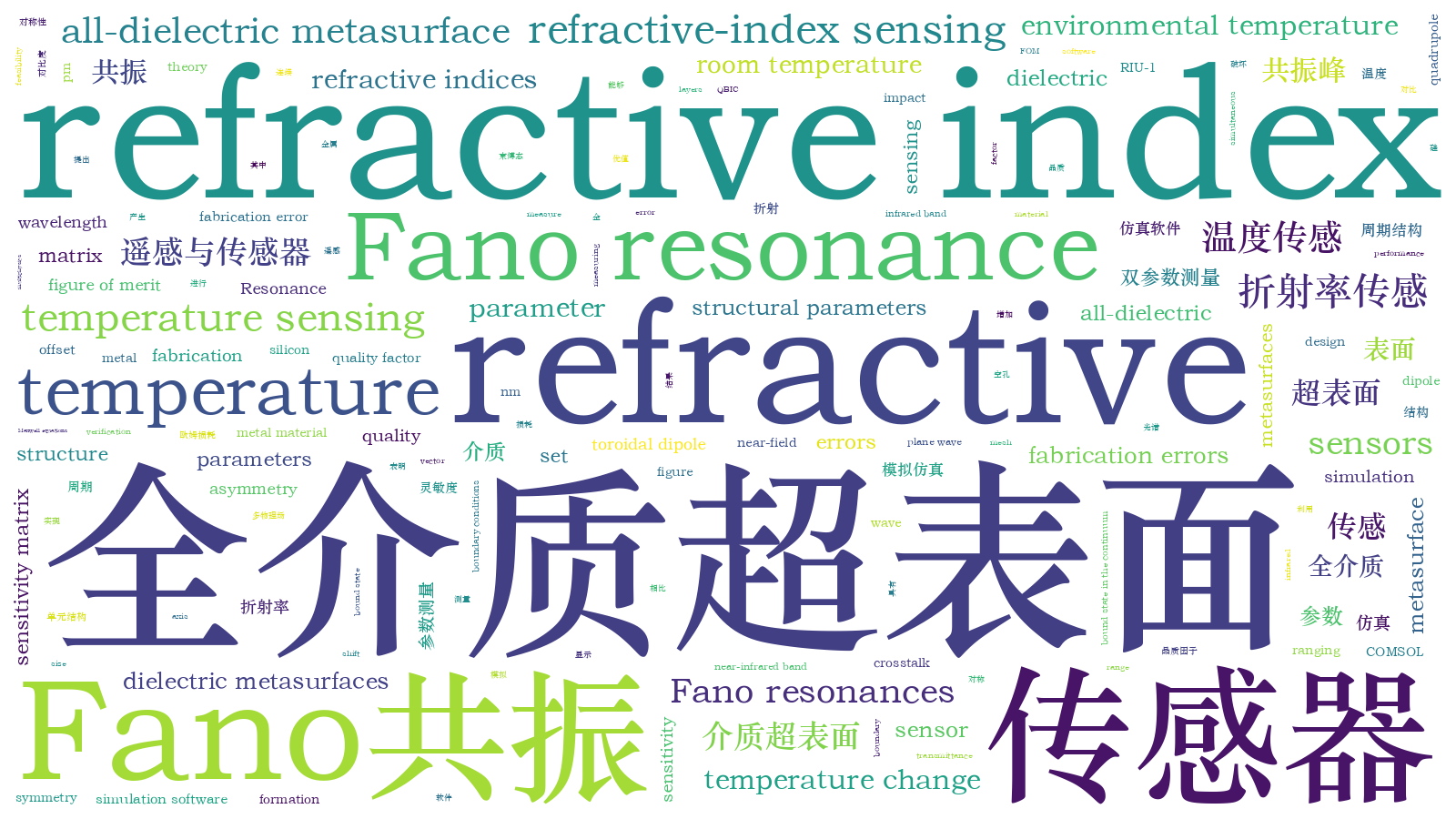基于Fano共振的全介质超表面双参数传感器
Currently, the performance of refractive-index sensors based on metal metasurfaces is limited by their low quality factors, due to significant Ohmic losses in the metal material. Sensors based on all-dielectric metasurfaces can overcome these disadvantages. However, most dielectric refractive-index sensors neglect the impact of temperature fluctuations. Hence, they experience crosstalk between the refractive index and environmental temperature. In this study, we design a dual-parameter sensor based on the “θ” shaped all-dielectric silicon metasurface. Two Fano resonance peaks are generated by adding an empty hole to break the symmetry of the periodic units in the structure. The sensor can simultaneously measure both the refractive index and temperature by measuring the wavelengths of the two Fano resonances.
In this study, we use the commercial multiphysics simulation software COMSOL to numerically solve Maxwell equations for an all-dielectric dual-parameter metasurface sensor. We set periodic boundary conditions along the x- and y- directions and place two ports above and below the metasurface structure in the z-direction. An incident plane wave, polarized along the x-axis, is set at the upper port. The zeroth-order plane-wave transmittance is calculated at the lower port. To prevent undesirable reflections, perfectly matched layers (PMLs) are introduced outside each port. The maximum finite-element mesh size is set to 1/10 of the minimum incident wavelength. The scanned wavelength range is 1000?1200 nm. The relationship between the Fano resonance and quasi-bound state in the continuum (QBIC) is analyzed by varying the structural asymmetry parameter of the metasurface and calculating the corresponding quality factors.
The designed structure exhibits high values of sensitivity, quality factor (Q), and figure of merit (FOM). Two Fano resonances can be generated by breaking the symmetry of the periodic unit structure. The first Fano resonance peak is a QBIC with an ultrahigh Q in the near-infrared band (Fig.3). The near-field distributions at the resonance show the existence of electric quadrupole and toroidal dipole resonances in the two Fano resonances, indicating distinct formation mechanisms for each Fano resonance peak (Fig.5). We obtain the refractive index sensitivities of the two Fano resonance peaks, by fixing the temperature at room temperature and calculating the resonance wavelengths for different environmental refractive indices (Fig.7). Similarly, we set the environmental refractive index to 1.33 (the refractive index of water) and calculate the resonance wavelengths at different temperatures, to obtain the temperature sensitivities of the two Fano resonances (Fig.9). When the environmental refractive index and temperature change simultaneously, the two Fano resonance wavelengths shift. By calculating the product of the inverse sensitivity matrix (whose elements are the previously calculated refractive index and temperature sensitivities) and a column vector composed of the shifts of the two resonance wavelengths, the change in the environmental refractive index and temperature can be inferred. This approach enables dual-parameter sensing of both the refractive index and temperature. For six sets of randomly preset values of the change in the environmental refractive index and temperature, the matrix theory predictions exhibit small errors of less than ±5% relative to the preset values (Table 1), confirming the feasibility of dual-parameter sensing. Regarding the impact of the structural fabrication error, the simulation results show that for fabrication errors ranging from -2 nm to 2 nm, the resultant changes in the two resonance wavelengths remain within 5 nm (Fig.10).
In this study, we propose a dual-parameter sensor based on the “θ”-shaped dielectric silicon metasurface. The sensor design includes an empty hole, which introduces a structural asymmetry and generates two Fano resonances. This unique feature enables the simultaneous sensing of the environmental temperature and refractive index, eliminating any crosstalk between the two parameters. By conducting calculations to optimize the structural parameters such as hole radius and offset, we obtain refractive index sensitivities of 278.9 nm/RIU and 230.0 nm/RIU for the first and second Fano resonances, respectively. Additionally, we obtain temperature sensitivities of 18.86 pm/℃ and 42.71 pm/℃, respectively. The maximum figure of merit and Q are 9387 and 9735, respectively. The near-field analysis reveals the existence of electric quadrupole and toroidal dipole resonances in the two Fano resonances, indicating different formation mechanisms for each Fano resonance peak. When the environmental refractive index or temperature changes, the resonance wavelengths are shifted. These shifts follow different rules for the two Fano resonance peaks, enabling the dual-parameter sensing of the refractive index and temperature using a sensitivity matrix. The verification results show that the matrix theory predictions exhibit small errors (less than ±5%) relative to the preset values of the environmental refractive index and temperature change. The simulation results show that for fabrication errors ranging from -2 nm to 2 nm, the resultant changes in both the resonance wavelengths are within 5 nm.
南雪莹, 刘会刚, 刘海涛. 基于Fano共振的全介质超表面双参数传感器[J]. 中国激光, 2024, 51(2): 0210002. Xueying Nan, Huigang Liu, Haitao Liu. All‑Dielectric Metasurface Dual‑Parameter Sensor Based on Fano Resonance[J]. Chinese Journal of Lasers, 2024, 51(2): 0210002.







